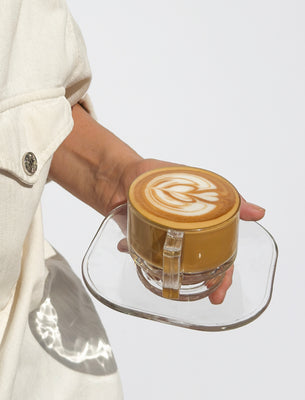Ever notice how a café matcha latte just hits differently? Silky. Balanced. Drinkable from first sip to last. Then you try making one at home, and suddenly the milk splits, the foam collapses, or the whole thing tastes a little flat.
It’s not your whisking. It’s not your matcha grade. It’s the milk texture working behind the scenes. The structure of the foam, the viscosity, and the way milk carries flavor are the hidden levers of matcha satisfaction.
In this blog, we’ll break down why texture matters, how different milks behave, and why Koatji’s slow-crafted, fermented oat & koji blend was designed to elevate your at-home matcha ritual.
Who This Guide Is For and Why Texture Matters More Than You Think
If you’ve ever tried to recreate your favourite café matcha latte at home and felt something was missing, read till the end. It’s also for anyone scrolling through dozens of non-dairy milks, trying to understand which one actually works with matcha, rather than against it.
Here’s what you’ll learn:
- Why the milk you choose completely changes how a matcha drink feels, foams, and tastes.
- How texture shifts between hot and iced drinks.
-
Where Koatji’s oat & Koji Milk fits among dairy, almond, and standard oat options.
Koatji is designed for individuals who value clean, organic ingredients and café-level mouthfeel. If matcha is part of your daily rhythm, the milk should feel just as intentional.
The Science of Matcha Latte Texture: Foam, Viscosity, and Flavor Carry
When we talk about the texture of a matcha latte, we’re talking about three main things:
- Microfoam: Tiny, uniform bubbles that create a velvety layer rather than big, airy foam that collapses fast.
- Viscosity: That balanced thickness, not heavy, not watery.
- Integration: How well the milk blends with whisked matcha without separating.
Water temperature, whisking technique, and milk composition all contribute to shaping that texture. Proteins help build microfoam.
Fats help keep it stable. Natural sugars contribute to the smoothness and cohesiveness of the drink.
Bigger bubbles? Airy but flimsy. Tight microfoam? Silky and café-style. Once you understand these mechanics, the milk becomes the most powerful variable you control.
Dairy vs Standard Oat vs Koatji: What’s Really in Your Matcha Milk
Let’s look at how different categories behave when poured into a matcha latte:
- Dairy Milk: Its proteins and fats create great foam, but the flavor can overpower matcha’s grassy, delicate notes.
- Standard Oat Milks: Often use gums, emulsifiers, and stabilizers to mimic body and foam. These can steam unpredictably or taste overly sweet or chalky.
- Koatji’s Oat & Koji Milk: Slow-crafted, fermented, organic, and completely free from gums, fillers, preservatives, and added sweeteners. Fermentation naturally develops subtle sweetness and a smooth mouthfeel.
What this means in your cup: Texture that feels silky, not heavy. Foam that holds its shape and flavour that supports matcha instead of flattening it. Koatji gives matcha space to shine while adding body through process and ingredients, not additives.
Inside Koatji’s Oat & Koji Blend: Fermentation, B-Vitamins, and Foam Behavior

Koji, a traditionally fermented rice, works with organic oats in a slow-crafted process that breaks down starches into natural sugars. This creates gentle sweetness and smooth consistency without adding sugar.
Koji also naturally contains vitamins B2 and B6.
Why this matters for matcha: The fermentation step yields a creamy matcha latte base that integrates seamlessly with whisked tea, rather than floating or separating. The resulting foam is fine-bubbled and stable, ideal for slow sipping, latte art, or layered iced pours.
Koatji achieves all this without gums or synthetic thickeners; the texture comes from real craft.
How Koatji Actually Behaves in a Matcha Latte: Hot, Iced, and Everyday Rituals
A hot matcha latte with Koatji has a distinct feel:
- The steam builds a dense, silky microfoam.
- The pour blends smoothly with whisked matcha.
- The top layer holds instead of collapsing.
In iced drinks, Koatji avoids that chalky residue some non-dairy milks leave behind. You get even color, less separation, and a clean, refreshing sip from start to finish.
In everyday rituals like your morning focus drink, an afternoon reset, or an after-dinner treat. Koatji behaves the same way: smooth pour, stable texture, and no coating sensation on the tongue. This consistency is intentional, developed through thousands of experiments with chefs and baristas.
Try This at Home: Simple Texture Tests to Feel the Difference

You don’t need fancy gear to compare milks, just innate curiosity.
- The Spoon Test: Stir your drink and lift the spoon. Notice how the foam clings and settles.
- The Swirl Test: Gently swirl your cup. Smooth surfaces mean tighter microfoam.
- The Split Test: Let the drink sit for 10-15 minutes. Compare the separation lines between different milks.
Run these tests with your favourite ceremonial matcha and Koatji. Your eyes and palate will tell you everything you need to know. Start a flexible subscription to Koatji’s Barista Oat & Koji Milk so you never run out of plant-based goodness.
How to Choose the Right Milk for Your Matcha Ritual
Here’s a simple decision tool for building your perfect daily ritual:
- “I want maximum foam and body, but with clean, organic ingredients.” Go for Koatji.
- “I don’t mind gums/emulsifiers and just want something cheap and widely available.” Standard oat milk variants (category-level reference only).
- “I want a more familiar, dairy-like flavour.” Dairy milks, with the note that they may overpower matcha’s subtle tones.
If matcha latte time is your grounding ritual, your calm moment, or your morning focus, the milk should feel thoughtfully chosen. Koatji brings organic oats, koji fermentation, natural sweetness, and slow-crafted texture together in one barista-ready carton.
Make Koatji Your Go-To Matcha Milk
Texture is what turns your at-home matcha into a café-level moment, and Koatji is crafted with that texture in mind.
Find Koatji across the continental U.S. states (excluding Alaska and Hawaii). Your matcha deserves milk that was made for it. Koatji was designed for just that.
Explore Koatji’s Barista Oat & Koji Milk and try it in your next matcha ritual!





